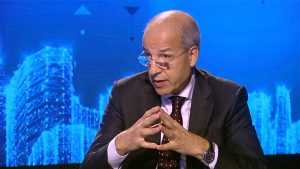The issue of gold smuggling from Libya reveals a complex crisis that goes beyond mere dimensions of corruption, shedding light on a unique dynamic between the existing reality and the stalled political solution.
It appears that the lack of a political solution horizon creates an environment where the prevalent “mafias” in western Libya seek to maintain their operations. The ongoing power struggle and rivalry among various armed factions and government officials reflect a complex relationship that does not carry political agendas between adversaries. Instead, it’s an attempt to maintain a certain level of conflict that feeds into the space where networks operate, draining Libyan wealth either directly or through sharing investments with foreign companies.

Background and Events…Revealing the Smuggling Operation
In May 2024, the Libyan Attorney General announced the arrest of the Director-General of Customs, Colonel Fahti Mekhlouf, and other officials at Misrata International Airport on charges of conspiring to smuggle 26 tons of gold bullion. Investigations revealed collusion between officials and other parties to smuggle the gold in violation of regulations and laws. Despite the magnitude of this economic corruption case, it also exposes another power struggle in western Libya. The gold smuggling issue was uncovered at the peak of the conflict between the outgoing Prime Minister, Abdul Hamid al-Dbeibeh, and the Governor of the Central Bank, Sadik Kabir.

The issue of gold smuggling came to light publicly in December last year when audio recordings were circulated on social media implicating the head of customs at Misrata Airport and the leader of the Joint Operations Room, Abu Al-Qasim Al-Samoudi, in this operation. The leaked recordings, obtained through the internal security apparatus, included calls revealing coordination between the implicated parties and the Administrative Control Authority. Certainly, a quantity of 26 tons of gold is significant, indicating the existence of a continuous and organized smuggling channel for a long time. This led the media to link this quantity to the disappearance of 26 tons from Libya’s coffers. However, investigations did not go in this direction; instead, they appeared to be settling scores or even deliberately tarnishing the reputation of the Governor of the Central Bank, Sadik Kabir.

Practically, the Governor of the Central Bank is not far from the conflicts among the networks that govern western Libya. The question is not about Sadik Kabir’s involvement in this matter but about the nature of the power struggles within the circles of political corruption. The media’s approach linking the disappearance of gold from the central bank to the smuggling issue is not coincidental; it represents mutual pressures between the parties, especially since the smuggling issue was leaked through security apparatuses. This echoes a similar struggle over the oil institution since the establishment of the Ministry of Oil and Gas in the Government of National Unity in March 2021, where a conflict arose between the Minister of Oil and Gas, Mohammed Aoun, and the Chairman of the National Oil Corporation, Mustafa Sanalla.

The broader picture… Main channels of smuggling
The Tibesti-Misrata-Turkey route is considered one of the main channels for gold smuggling in Libya. Gold is smuggled illegally from the Tibesti region in Chad through Misrata and then to Turkey. The gold-producing region in Chad has witnessed wars and conflicts with the regime of Idriss Deby to the extent that some reports suggest he was killed by smuggling networks. Regardless of the details governing all stages of smuggling, the issue of gold coming from Chad complicates the smuggling process that has surfaced in the Libyan political scene. It illustrates that what happened is an element in the power struggle and influence over oil revenues in western Libya. The smuggling of 26 tons of gold is a small amount compared to the smuggling operations of Libyan oil revenues, a topic that has not received sufficient attention despite its media coverage.

The issue of oil does not differ much from the smuggling of gold, although the focus on oil often addresses direct smuggling operations rather than official export revenues. In western Libya, specialized gangs are active in smuggling fuel to neighboring countries, whether by land towards Tunisia and African countries or by sea towards Malta. These gangs operate through interconnected networks with all the forces controlling western Libya. The National Oil Corporation estimates the losses from fuel smuggling outside Libya to be $750 million annually.

The raid by elements of the Joint Force in Misrata, targeting the office branch of the Attorney General, to arrest the head of the customs center at Misrata Airport, Fathi Makhloof, is part of a comprehensive scenario involving the interplay between corruption networks and state institutions. It’s a part of a broader context that reflects the deteriorating security situation, highlighting a phenomenon of relationships that foster an environment incompatible with stability or political resolution. Ultimately, there are more than just beneficiaries of instability; it also establishes a form of control over Libyan society through centers of political power reliant on their corruption networks.

The case of smuggling 26 tons of gold in Libya is not just a simple criminal incident, but rather part of a complex network of conflicts, influence, and corruption. Analyzing this issue quickly leads to the broader political situation, fundamentally governed by political impotence, and the establishment of a special structure of the state in western Libya, primarily based on networks that are the shadow governing all existing conflicts, ultimately behind the failure to achieve any comprehensive political solution.
By Mazen Bilal
Libya’s Waha Oil Company expects to increase production by end of 2024
